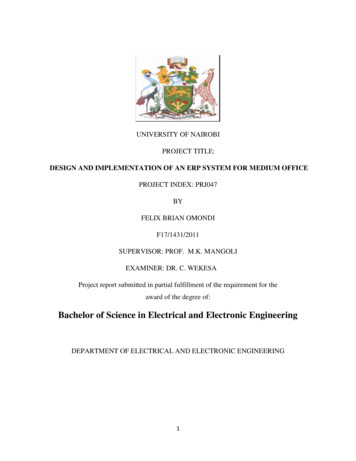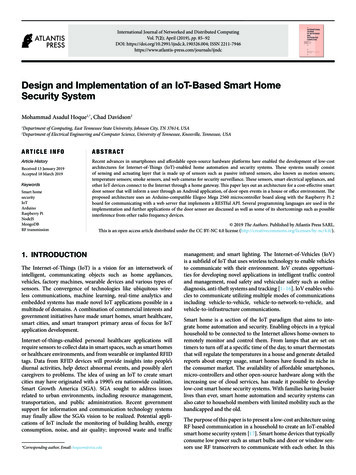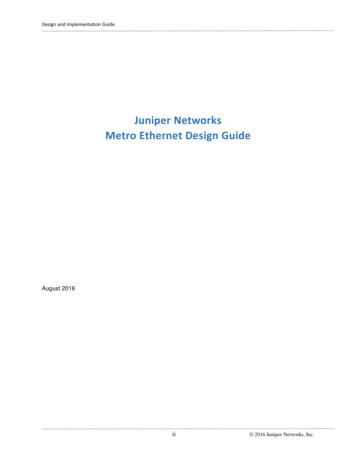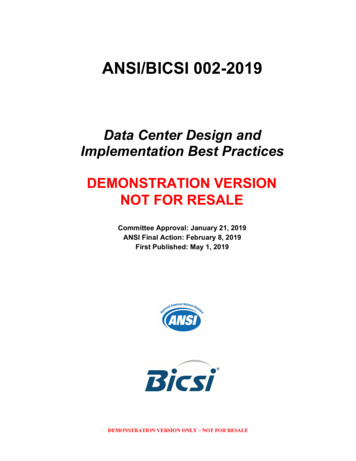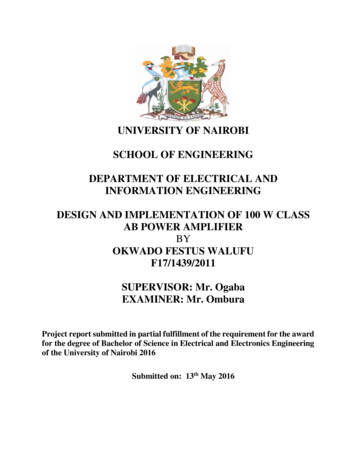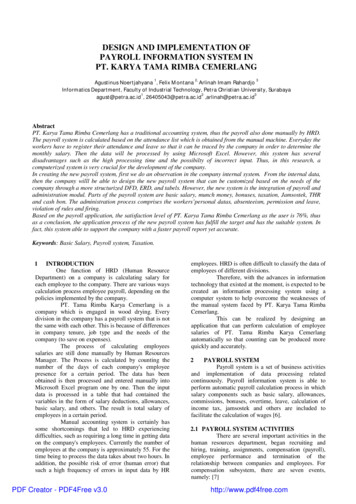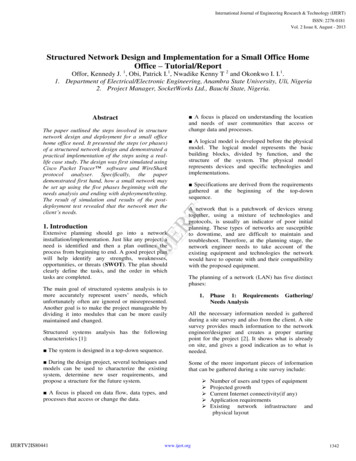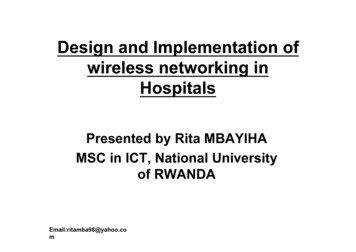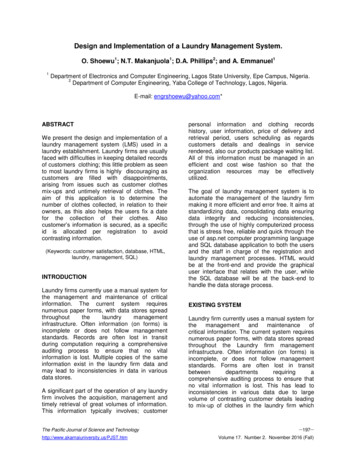
Transcription
Design and Implementation of a Laundry Management System.O. Shoewu1; N.T. Makanjuola1; D.A. Phillips2; and A. Emmanuel11Department of Electronics and Computer Engineering, Lagos State University, Epe Campus, Nigeria.2Department of Computer Engineering, Yaba College of Technology, Lagos, Nigeria.E-mail: engrshoewu@yahoo.com*ABSTRACTWe present the design and implementation of alaundry management system (LMS) used in alaundry establishment. Laundry firms are usuallyfaced with difficulties in keeping detailed recordsof customers clothing; this little problem as seento most laundry firms is highly discouraging ascustomers are filled with disappointments,arising from issues such as customer clothesmix-ups and untimely retrieval of clothes. Theaim of this application is to determine thenumber of clothes collected, in relation to theirowners, as this also helps the users fix a datefor the collection of their clothes. Alsocustomer’s information is secured, as a specificid is allocated per registration to avoidcontrasting information.(Keywords: customer satisfaction, database, HTML,laundry, management, SQL)INTRODUCTIONLaundry firms currently use a manual system forthe management and maintenance of criticalinformation. The current system requiresnumerous paper forms, with data stores . Often information (on forms) isincomplete or does not follow managementstandards. Records are often lost in transitduring computation requiring a comprehensiveauditing process to ensure that no vitalinformation is lost. Multiple copies of the sameinformation exist in the laundry firm data andmay lead to inconsistencies in data in variousdata stores.A significant part of the operation of any laundryfirm involves the acquisition, management andtimely retrieval of great volumes of information.This information typically involves; customerThe Pacific Journal of Science and ersonal information and clothing recordshistory, user information, price of delivery andretrieval period, users scheduling as regardscustomers details and dealings in servicerendered, also our products package waiting list.All of this information must be managed in anefficient and cost wise fashion so that theorganization resources may be effectivelyutilized.The goal of laundry management system is toautomate the management of the laundry firmmaking it more efficient and error free. It aims atstandardizing data, consolidating data ensuringdata integrity and reducing inconsistencies,through the use of highly computerized processthat is stress free, reliable and quick through theuse of asp.net computer programming languageand SQL database application to both the usersand the staff in charge of the registration andlaundry management processes. HTML wouldbe at the front-end and provide the graphicaluser interface that relates with the user, whilethe SQL database will be at the back-end tohandle the data storage process.EXISTING SYSTEMLaundry firm currently uses a manual system forthemanagementandmaintenanceofcritical information. The current system requiresnumerous paper forms, with data stores spreadthroughout the Laundry firm managementinfrastructure. Often information (on forms) isincomplete, or does not follow managementstandards. Forms are often lost in transitbetweendepartmentsrequiringacomprehensive auditing process to ensure thatno vital information is lost. This has lead toinconsistencies in various data due to largevolume of contrasting customer details leadingto mix-up of clothes in the laundry firm which–197–Volume 17. Number 2. November 2016 (Fall)
thus leads to delay in collecting the clothesback.challenges faced, technologies used andunresolved problems. This forms the basis forimplementing later versions.PROPOSED SYSTEMThe Laundry Management System is designedfor any Laundry firm to replace their existingmanual, paper based system. The new systemis in form of an e-registration system to controlthe following; customer information, products,services, users, carts and receipt. Theseservices are to be provided in an efficient, costeffective manner, with the goal of reducing thedelay and resources currently required for suchtasks as clothes details are bounded to aparticular customer with a given id. Since theexisting system makes use of tediousadministrative tasks, lots paper work and time, inwhich full information cannot be gotten frombusy customers.The goal of the laundry management system isto provide a computerized process that is stressfree, reliable and quick through the use ofasp.net computer programming language andSQL database application to the users and staffsin charge of the registration of customers andlaundry management processes. HTML wouldbe at the front-end and provide the graphicaluser interface that relates with the user, whilethe SQL database will be at the back-end tohandle the data storage process.EXISTINGSYSTEMSYSTEMOVERPROPOSEDThe proposed system seeks to simplify theusers operation. The stages involved in theregistration process must be reduced to nearestminimum if it is to be faster and moreconvenient. The crude way of registration usingpaper based processes of registration are timeconsuming and expensive. The customers arerest assured security and availability of theirclothing as at when due, as information areprotected using a specific Id.An increase in the number of customer willobviously mean more paper work and lessefficiency of the existing system. Hence, manyLaundry firms are finding the proposed system abetter and more effective way of catering for theinconvenience and inefficiency of the existingsystem of registration. The proposed system forlaundry firms plays a vital role in the transitionand if effectively implemented, it should be ableto:Reduce paper work and redundancythereby improving productivity andlowering cost of printing and purchasingregistration materials annually. It aidsthe administrative in data managementof customers, by allowing the user tosearch for any customer with ease.MATERIALS AND METHODSFigure 1: Diagram of the Front and Back EndRelationship.The objective of this work is to implement amanagement system that will streamlineregistration process, reduce administrative tasksand paper work so as to improve the registrationcycle process flow.LITETRATURE REVIEWThis section takes critical review of existingsystem implemented, the success factors,The Pacific Journal of Science and ystem Analysis and DesignSystem analysis is a method of problem-solvingthat deals with the breaking down of a systeminto components parts in order to study how wellthe individual parts work and interact toaccomplish their purpose. It involves the processof enumerating the existing problems, analyzingthe proposed system for costs and benefits,analyzing the system and user requirements andconsidering possible alternative system.System analysis is important in the design ofsubsequent systems. System design consists ofdesignactivitiesthatproducesystemspecifications which satisfy the functional–198–Volume 17. Number 2. November 2016 (Fall)
requirements that have been developed in thesystem analysis process. System design isbasically the structural implementation of systemanalysis. The proposed system is beingdesigned in such a way that users only need toinput their customer data which is then enteredinto a computer database. Customers will beassigned a specific id on registrationTOOLSGraphical User InterfaceHyper-Text Markup Language (HTML)is thebasic language used for creating web pages andother information that can be displayed in a webbrowser. The purpose of a web browser is toread HTML documents and compose them intovisible or audible web pages. The browserdoesn’t display the HTML tags, but uses thetags to interpret the concept of the page.Hyper-Text Markup LanguageHTML elements forms the building blocks of allwebsites, allows images and objects to beembedded and can to be used to createinteractive forms. It provides a means to createstructured documents by denoting structuralsemantics for txt such as heading, paragraphs,lists, links, quotes and so on. It can also embedscripts written in languages such as JavaScriptwhich affect the behavior of HTML web pages.HTML consists of several key components,including tags and their attributes, characterbased data types, character references andentity references. An important component is thedocument type declaration, which triggersstandards mode rendering.Cascading Style SheetsCSS is a style sheet language used fordescribing the look and formatting of adocument written in a markup language. Whilemost often used to style web pages andinterfaces written in HTML and XHTML, thelanguage can be applied to any kind of XMLdocument, including plain XML, SVG and XUL.CSS is designed basically to enable theseparation of document content from documentpresentation, including elements such as layout,The Pacific Journal of Science and olors and fonts. This improves contentaccessibility, provides flexibility and control inthe specification of presentation characteristics,enable multiple pages to share formatting andreduce complexity and repetition in the structuralcontent, for instance, allowing tableless webdesign.CSS can also allow the same markup page tobe presented in different styles for differentrendering methods such as on-screen, in printand on Braille-based, tactile devices. CSSspecifies a priority scheme to determine whichstyle rules apply if more than one rule matchesagainst a particular element. Priorities arecalculated and assigned to rules, so that theresults are predictable.Client-side Script(JAVASCRIPT)JavaScript is a new scripting language forWebPages. Scripts written with java script canbe embedded into your HTML pages. With javascript you have many possibilities for enhancingyour HTML page with interesting elements. Forexample you are able to respond to userinitiated events quite easily. Some effects thatare now possible with java script were sometime ago only possible with CGI. So you cancreate really sophisticated pages with the helpsof java script on the Internet.SQL(Structured Query Language)To work with data in a database, you must use a setof commands and statements (language) defined bythe DBMS software. There are several differentlanguages that can be used with relationaldatabases; the most common is SQL. Both theAmerican National Standards Institute (ANSI) andthe International Standards Organization (ISO) havedefined standards for SQL. Most modern DBMSproducts support the Entry Level of SQL-92, thelatest SQL standard (published in 1992).SQL Server FeaturesMicrosoft SQL Server supports a set of features thatresult in the following benefits: Ease of installation, deployment, and use:SQL Server includes a set of administrative anddevelopment tools that improve your ability to–199–Volume 17. Number 2. November 2016 (Fall)
install, deploy, manage, and use SQL Serveracross several sites. Scalability: The same database engine can beused across platforms ranging from laptopcomputers running Microsoft Windows 95/98 tolarge, multiprocessor servers running MicrosoftWindows NT , Enterprise Edition.Data warehousing: SQL Server includes toolsfor extracting and analyzing summary data foronline analytical processing (OLAP). SQLServer also includes tools for visually designingdatabases and analyzing data using Englishbased questions.System integration with other serversoftware: SQL Server integrates with e-mail,the Internet, and Windows.System RequirementSystem requirement is a description of theneeds of a user for an information system. Theunique requirements of a user are identifiedhere.User RequirementsTo gain access to the laundry managementsystem resources, the user would need: A personal computerA usernameA genuine passwordUser-Interface RequirementsUser interfaces are the registration pagesdeveloped for the customers and users toregister and manage the items brought. Theyconsist of the following: login page (Username and password)Product pageView customersView recordsSearch for customersRegister a new userPrint ReceiptModeling The SystemThe laundry application flow diagram is shown below:Figure 1: Flow Chart Diagram.The Pacific Journal of Science and ��200–Volume 17. Number 2. November 2016 (Fall)
DATAFLOW DIAGRAMFigure 2: Laundry Application Flowchart.Figure 3: System Design and Architecture.The Pacific Journal of Science and ��201–Volume 17. Number 2. November 2016 (Fall)
DESIGN IMPLEMENTATION AND RESULTSDesign implementation refers to the real live running of the designed program. This section consists ofthe program modules, showing what they do, and how the system can be deployed.Figure 4: Login Page.Figure 6: Search Customer Page.The Pacific Journal of Science and igure 5: Homepage.Figure 7: Searched Customer Page.–202–Volume 17. Number 2. November 2016 (Fall)
Figure 8: User Registration Page.Figure 10: Products Page.The Pacific Journal of Science and igure 9: Customer Registration Page.Figure 11: Product Registration Page.–203–Volume 17. Number 2. November 2016 (Fall)
Figure 12: Receipt Page.2.Phillips, P. 2003. e-Business Strategy. McGrawHill: London, UK.3.Whitten, Bentley, and Dittman. 2004. SystemAnalysis and Design Methods (5th ed). New York,NY.4.PerlScriptsJavaScripts.com. 2006. “SQL Tutorial,Database Commands, Beginners Guide, com/tutorials/sql/index.html,Accessed 3rd of February, 2006.5.HTML Elements. W3schools. Retrieved 16 March,2015. Journals of science of technologyIt provides a friendly graphical user interfacewhich proves
The goal of laundry management system is to automate the management of the laundry firm making it more efficient and error free. It aims at standardizing data, consolidating data ensuring data integrity and reducing inconsistencies, through the use of highly computerized process that is stress free, reliable and quick through the
